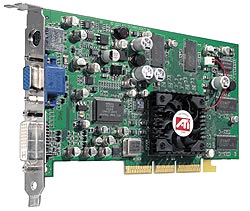ATI introduced its Radeon line of graphics adaptors shortly after
Nvidia had released their all conquering Geforce 2 GTS chipset. Though the
Radeon line subsequently diversified, the original intent was to deliver a
chipset which could compete with the GTS in terms of sheer performance, but also
scale better from 16 to 32 bit colour without losing much in terms of frame
rates. More or less, it worked.
The original Radeon DDR card, though slower than the GTS in lower
resolution benchmarks, was quite close in performance, and in high resolution
(1024x768 and above) 32 bit colour, actually had a considerable advantage. For a
brief period, the Radeon 32MB DDR was the fastest card available for gamers with
tricked-out systems.
Unfortunately for ATI, Nvidia soon brought out its GTS-enhancing
Detonator 3 drivers and introduced the GeForce 2 Ultra chipset, which left the
Radeon DDR in the dust at all resolutions. ATI's only response was a 64MB
version of the DDR card, a feat which had already been matched by the GTS
chipset. Predictably, this did not make the Radeon much more competitive, and
Nvidia resumed its domination of the 3D chipset market, despite ATI's almost
covert release of the slightly beefed up Radeon SE.
Move forward to this year,
and Nvidia's release of the Geforce3 chipset with support for DirectX 8.0 and
'revolutionary' programming flexibility for graphics coders. ATI is now a generation
and a half behind its competitor in the graphics accelerator arena... you know
this can't last.
ATI's newest graphics chipset, formally known as the R200, will be first seen
in the 8500 line of cards. Comprising the Radeon 8500, a straight 64MB gaming
card designed to compete directly with the GF3, and the 8500DV, a successor to
the very successful Radeon all-in-wonder. The R8500 will also add built-in
firewire support into the mix.
Again ATI is releasing its new chipset after Nvidia has had
time to build up support for theirs. This time though, ATI's card has a better
hook. The 8500 chipset is the first chipset to be fully compatible with Microsoft's
soon to be released (with Windows XP) DirectX 8.1 API, and is armed with at
least one unique feature which modern games should be able to actually use (once
suitably patched).
The Radeon 8500 Chip
The Radeon 8500 GPU is a .15 micron process, 60 million
transistor chip with 4 rendering pipelines, each with two texture units. This
setup differs from the original Radeon considerably, doubling the amount of
pixel rendering pipelines while dropping the third texturing unit on each
pipeline that the original Radeon sported. While the rendering pipeline setup of
the Radeon 8500 is superficially identical to that of the Geforce 3, the
difference comes with the 8500's full hardware support for DirectX 8.1's pixel
shader 1.4 spec., which will allow it to combine three of its four pipelines to
render a pixel with six different texture samples in a single pass (using 3
clock cycles).
Though the Geforce 3 has the same amount of rendering
pipelines and texture units, it currently supports only pixel shader 1.3 and
lower, limiting it to a maximum output of 2, 4 texture pixels in a single pass
(2 clock cycles), a feat which the 8500 GPU is also capable of. The Geforce 3
will require an additional rendering pass to complete a pixel with more than
four texture samples.
As with the original Radeon's adoption of a third
texturing unit per pipeline, it remains to be seen whether support for the
8500's ability to add an additional two textures per pixel per pass will
actually be instituted by developers in the 9 months or so before the inevitable
Next Generation Chipset comes out. More on this later in the article.
The 8500 chip will be clocked at 250MHz, while the DDR
memory will run at 275MHz. This gives the 8500 chip theoretical fill rates of 1
Gigapixel (250MHz x 4 pixel rendering pipelines) and 2 Gigatexels (250Mhz x 4
pipelines x2 for two texturing units per pipeline). Compare this to the 366
Megapixel/1.1 Gigatexel numbers of its predecessor and the 800 Megapixel/1.6
Gigatexel of the Geforce3 if you like that sort of thing. Keep in mind that as
3D games become more complex, these numbers will not add up to equivalent
real world performance.
The memory controller is a slightly upgraded
version of the original Radeon's, a 128 bit DDR interface. The only difference
is that instead of fetching 128 bits of data twice per clock cycle, the
controller now waits for 256.

